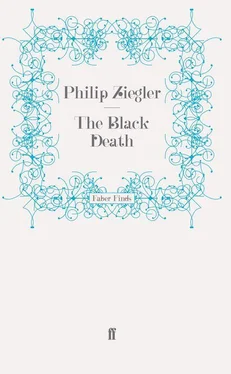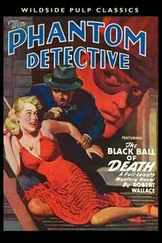St Marie Laumont in the same area lost four hundred people, or over half the population. The epidemic there raged for three months and had ended by September 1348. Amiens, it seems, must have suffered a second attack or perhaps, as occasionally happened in the larger cities, wasted away gradually over a year or more rather than succumbed to a brief but shattering epidemic. As late as June 1349 the King authorized the Mayor to open a new cemetery on the grounds that: ‘The mortality… is so marvellously great that people are dying there suddenly, as quickly as between one evening and the following morning and often quicker than that.’ {147} 147 43 Thierry, Recueil des Monuments inédits de L’Histoire du Tiers État , Vol. I, p. 544.
Meanwhile the Black Death seeped across every corner of France. Bordeaux it had reached in August 1348 and there caught and killed Princess Joan, daughter of King Edward III of England, on her way to marry the son of the King of Castile. The news of her death reached England at much the same time as the plague itself.
To the North East the Black Death moved slowly on towards Flanders and the Low Countries. ‘It is almost impossible,’ wrote Gilles Li Muisis {148} 148 44 ‘Chronicon majus Aegidii li Muisis’, De Smet, Receuil des Chroniques de Flandres, Vol. II, p. 280.
‘to credit the mortality throughout the whole country. Travellers, merchants, pilgrims and others who have passed through it declare that they have found cattle wandering without herdsmen in the fields, towns and waste-lands; that they have seen barns and wine-cellars standing wide open, houses empty and few people to be found anywhere…. And in many different areas, both lands and fields are lying uncultivated.’
Professor Renouard says that, though mortality in the French towns was terrifyingly high, the country escaped comparatively lightly. {149} 149 45 Y. Renouard, Population, Vol. III, 1948, p. 459.
In many areas this was certainly true but, though Li Muisis’s account may well have been embellished in the interests of the picturesque, there are too many descriptions like it to accept Renouard’s statement as invariably valid. At Givry, a large Burgundian village near Chalon-sur-Saône of between twelve and fifteen hundred inhabitants, the average death rate in the years before the plague was thirty each year. Between 5 August and 19 November 1348 six hundred and fifteen people died. In Saint-Pierre-du-Soucy, a rural parish in Savoy, the number of households dwindled from one hundred and eight in 1347 to sixty-eight at the end of 1348 and fifty-five in 1349. In the seven neighbouring parishes, all farming communities with small and scattered populations, the number of households fell from three hundred and three to one hundred and forty-two. {150} 150 46 E. Carpentier, ‘Autour de la Peste Noire’, op. cit, p. 1065.
In areas such as these, at least, something close to half the population must have perished.
In the summer of 1349, the Black Death reached Li Muisis’s own city of Tournai. The Bishop, John de Pratis, was one of the first to die; then came a lull during which the citizens told themselves that they had been let off lightly. But by August the plague was raging with renewed strength:
Every day the bodies of the dead were borne to the churches, now five, now ten, now fifteen, and in the parish of St Brice sometimes twenty or thirty. In all parish churches the curates, parish clerks and sextons, to get their fees, rang morning, evening and night the passing bells, and by this the whole population of the city, men and women alike, began to be filled with fear.
The Town Council acted firmly to restore public confidence and check the collapse in moral standards which was likely, they feared, to bring down upon the city a still more ferocious measure of divine vengeance. Men and women who, although not married, were living together as man and wife were ordered either to marry at once or to break off their relationship. Swearing, playing dice and working on the Sabbath were prohibited. No bells were to be rung at funerals, no mourning worn and there were to be no gatherings in the houses of the dead. New graveyards were opened outside the city walls and all the dead, irrespective of their standing in the city or the grandeur of their family vaults, were in future to be buried there.
The measures seem to have been successful; if not in checking the Black Death then at least in raising the moral tone of the community. Li Muisis reported that the number of people living in sin dwindled rapidly, swearing and work on the Sabbath almost ended, the dice manufacturers became so discouraged with their sales-figures that they turned their products into ‘round objects on which people told their Pater Nosters.’ But gratifying though this must have been, the death roll was still terrifyingly high. ‘It was strange,’ said the chronicler, that ‘the mortality was especially great among the rich and powerful.’ Strange indeed, especially since he went on to comment: ‘Deaths were more numerous about the market places and in poor, narrow streets than in broader and more spacious areas.’ There seems no reason to doubt that in Tournai, as in every other city, the rich man who remained prudently secluded had a better chance of survival than the poor man who, like it or not, was forced to live cheek-by-jowl with his neighbours. But his chance was not necessarily a high one: ‘…no one was secure, whether rich, in moderate circumstances or poor, but everyone from day to day waited on the will of the Lord.’
* * *
The Middle Ages were described by Koyré, the great historian of science, as the period of à peu près . Everything is seen through a glass darkly; though here and there it may be possible to identify detail with fair certainty, for the most part a bold, impressionistic picture is the best that can be hoped for. No more in France than in Italy can it be said what proportion of the population died. Gui de Chauliac spoke of three quarters, other chroniclers of half; Professor Renouard, who has studied the subject as closely as anyone, can do no better than estimate that the death rate varied from an eighth to two-thirds according to the area.
But even if such details were known to us we would still be very far from understanding what the Black Death meant to medieval man. Some hazy outline of the reactions of the French emerges from the records of the chroniclers. Men seem to have taken refuge in frenetic gaiety. It was not only in Tournai that dice and lechery were the order of the day. ‘It is a curious fact,’ observed Papon, {151} 151 47 De la Peste… , op. cit., Vol. 1. p. 123.
‘that neither the flail of war nor of plague can reform our nation. Dances, festivals, games and tournaments continued perpetually; the French danced, one might say, on the graves of their kinsmen….’ The standards of society were relaxed; debauchery was common; thrift and continence forgotten; the sacred rules of property ignored; the ties of family and friendship denied; let us eat and drink, for tomorrow we shall die.
It is dangerously easy to allow the prejudiced records of a handful of priestly and conservative chroniclers to delude one into a vision of Europe studded with Sodoms and Gomorrahs and echoing from end to end with the rattle of dice and the laughter of tipsy courtesans. But it would be hardly less foolish to let one’s rejection of such fantasies blind one to the very real degeneracy of life during the plague. The great nobles and churchmen, the richest merchants, withdrew from the city; those who were left drank, fornicated or skulked in cellars according to their inclinations. To none of them could it have seemed likely that his life would drag on for more than a few painful weeks. With no future to await and the threat of annihilation hanging over all he cared for, how could medieval man be expected to behave with responsibility? Honesty, decency and sobriety were by no means dead but they must, at times, have been uncommonly hard to find. In Paris at least there had been something not far removed from a complete collapse of public and private morality. This was not the least of the penalties which the Black Death exacted from its victims.
Читать дальше












